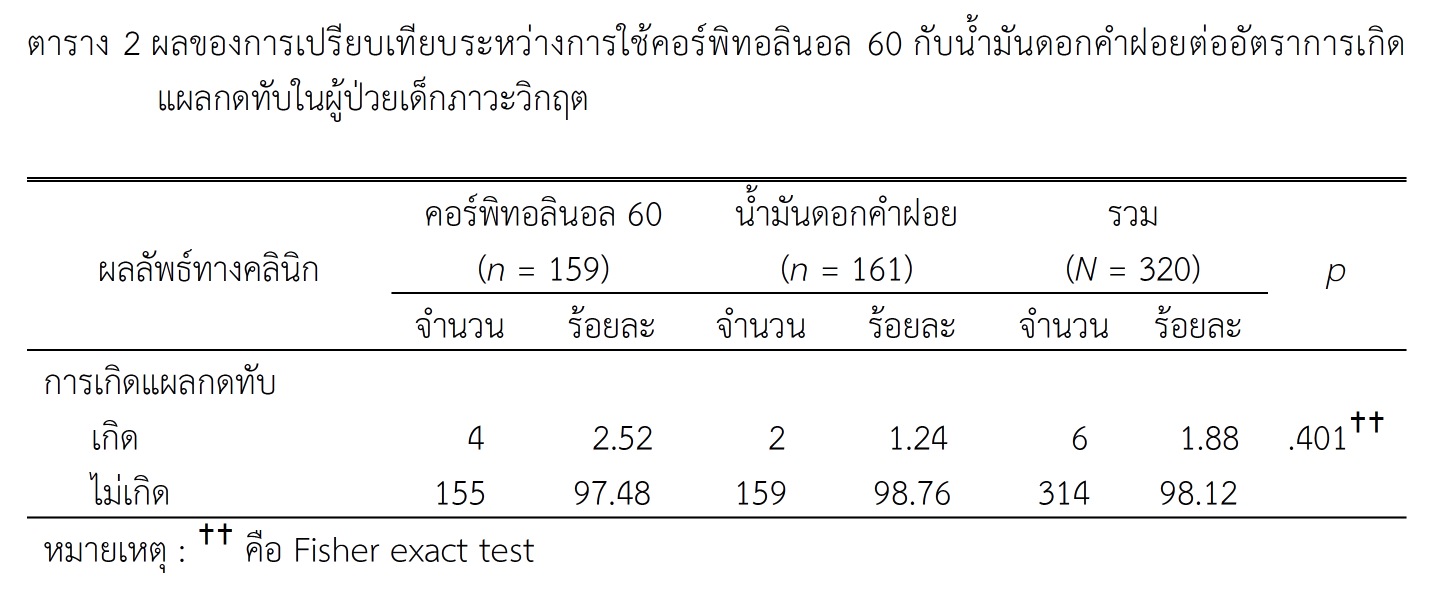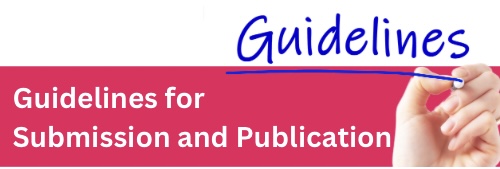A COMPARISON OF CORPITOLINOL 60 AND SAFFLOWER OIL FOR PRESSURE INJURY PREVENTION IN CRITICALLY ILL CHILDREN: THE RANDOMIZED CONTROLLED TRIAL WITH DOUBLE-BLINDED
Keywords:
corpitolinol 60, safflower oil, pressure injury, critically ill childrenAbstract
The randomized controlled trial with double-blinded aimed to compare the effect of caring for pediatric patients with safflower oil versus Corpitolinol 60 on the rate of pressure injuries in new pediatric patients. The participants were critically ill children who were hospitalized in PICU, Ramathibodi Hospital. The block of four randomization technique, using computer, was applied to recruit the participants into the study. The participants were randomly assigned to the Corpitolinol60 group (n = 159) and the safflower oil group (n = 161). The Data collection used the record form, record form of the pressure injury, and Braden Q scale. The sensitivity and specificity of Braden Q score were .92 and .59, respectively. The area under the curve (AUC) was found as .84. Data were analyzed using descriptive statistics, Chi-square test, and Fisher exact test.
The results of study revealed that genders, ages, diagnosis, criteria of ICU admission, sedative drugs, vasoactive drugs, using ventilator, hypoxemia, enteral feeding, immobilization, defecation frequency, serum albumin, nutrition profile, length of stay in ICU, and Braden Q score were no statistically significant difference between both groups. Moreover, the rate of pressure injuries in new pediatric patients was no significant difference between Corpitolinol 60 and safflower oil. Therefore, safflower oil was non-inferior to Corpitolinol 60 in prevention of pressure injury among critically ill children.
Downloads
References
Baharestani, M. M., & Ratliff, C. R. (2007). Pressure ulcers in neonates and children: An NPUAP white paper. Advances in Skin & Wound Care, 20(4), 208–220.
Bernabe, K. Q. (2012). Pressure ulcers in the pediatric patient. Current Opinion in Pediatrics, 24(3), 352–356.
Cai, J. B., Li, W. Q., Wen, R. C., Jiang, C., Li, X. K., & Li, H. Y. (2018). Expression of oleosin-rhFGF9 fusion protein in Carthamus tinctorius and determination of hair regeneration and wound repair potential in mice. China Journal of Chinese Materia Medica, 43(13), 2758–2763.
Chiari, P., Giorgi, S., Ugolini, D., Montanari, M., Giudanella, P., Gramantieri, A., . . . Taddia, P. (2012). Randomized controlled trial on the effectiveness of Corpitolinol 60 in the prevention of pressure sores in patients undergoing surgery. Assistenza Infermieristica e Ricerca (AIR), 31(3), 131–137.
Cummins, K. A., Watters, R., & Leming-Lee, T. (2019). Reducing pressure injuries in the pediatric intensive care unit. The Nursing clinics of North America, 54(1), 127–140.
Curley, M. A., Razmus, I. S., Roberts, K. E., & Wypij, D. (2003). Predicting pressure ulcer risk in pediatric patients: The braden q scale. Nursing Research, 52(1), 22–33.
Ferreira, M. K. M., Gurgel, S. S., Lima, F. E. T., Cardoso, M. V. L. M. L., & Silva, V. M. D. (2018). Instruments for the care of pressure injury in pediatrics and hebiatrics: An integrative review of the literature. Revista latino-americana de enfermagem, 26, e3034.
Guidoni, M., de Christo Scherer, M. M., Figueira, M. M., Schmitt, E. F. P., de Almeida, L. C., Scherer, R., . . . Fronza, M. (2019). Fatty acid composition of vegetable oil blend and in vitro effects of pharmacotherapeutical skin care applications. Brazilian Journal of Medical and Biological Research, 52(2), e8209.
Kottner, J., Hauss, A., Schlüer, A. B., & Dassen, T. (2013). Validation and clinical impact of paediatric pressure ulcer risk assessment scales: A systematic review. International Journal of Nursing Studies, 50(6), 807–818.
Langer, G., & Fink, A. (2014). Nutritional interventions for preventing and treating pressure ulcers. The Cochrane Database of Systematic Reviews, 2014(6), CD003216.
Liao, Y., Gao, G., & Mo, L. (2018). Predictive accuracy of the braden q scale in risk assessment for paediatric pressure ulcer: A meta-analysis. International Journal of Nursing Sciences, 5(4), 419–426.
Lin, T. K., Zhong, L., & Santiago, J. L. (2017). Anti-inflammatory and skin barrier repair effects of topical application of some plant oils. International Journal of Molecular Sciences, 19(1), 70.
Lu, Y-F., Yang, Y., Wang, Y., Gao, L-Q., Qiu, Q., Li, C., & Jin, J. (2015). Predicting pressure ulcer risk with the Braden Q scale in Chinese pediatric patients in ICU. Chinese Nursing Research, 2(1), 1-5.
Matthaus, B., Özcan, M. M., & Al Juhaimi, F. Y. (2015). Fatty acid composition and tocopherol profiles of safflower (Carthamus tinctorius L.) seed oils. Natural Product Research, 29(2), 193–196.
Noonan, C., Quigley, S., & Curley, M. A. (2011). Using the braden q scale to predict pressure ulcer risk in pediatric patients. Journal of Pediatric Nursing, 26(6), 566–575.
Qiang, W., Zhou, T., Lan, X., Zhang, X., Guo, Y., Noman, M., . . . Li, H. (2018). A new nanoscale transdermal drug delivery system: Oil body-linked oleosin-hEGF improves skin regeneration to accelerate wound healing. Journal of Nanobiotechnology, 16(1), 62.
Razmus, I., & Bergquist-Beringer, S. (2017). Pressure ulcer risk and prevention practices in pediatric patients: A secondary analysis of data from the National Database of Nursing Quality Indicators®. Ostomy/ Wound Management, 63(2), 28–32.
Wood, J., Brown, B., Bartley, A., Margarida Batista Custódio Cavaco, A., Roberts, A. P., Santon, K., & Cook, S. (2019). Reducing pressure ulcers across multiple care settings using a collaborative approach. BMJ Open Quality, 8(3), e000409.
Zhang, L. L., Tian, K., Tang, Z. H., Chen, X. J., Bian, Z. X., Wang, Y. T., . . . Lu, J. J. (2016). Phytochemistry and pharmacology of Carthamus tinctorius L. The American Journal of Chinese Medicine, 44(2), 197–226.

Downloads
Published
How to Cite
Issue
Section
License
Copyright (c) 2023 JOURNAL OF THE POLICE NURSES

This work is licensed under a Creative Commons Attribution-NonCommercial-NoDerivatives 4.0 International License.
ผลงานที่ได้ตีพิมพ์แล้วจะเป็นลิขสิทธิ์ของวารสารพยาบาลตำรวจ














